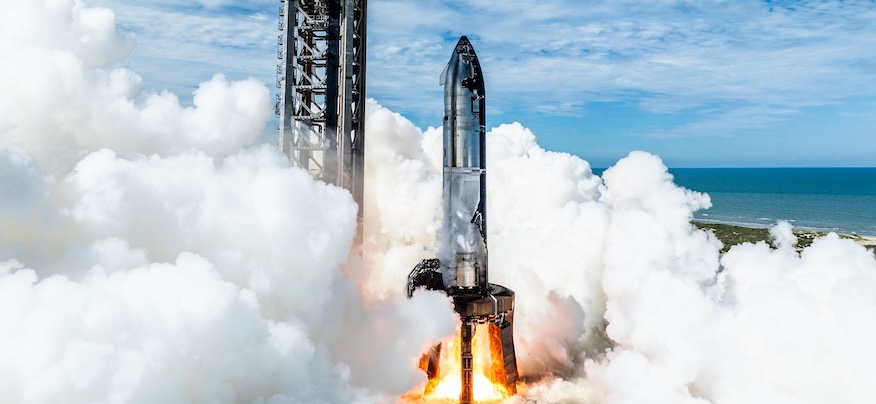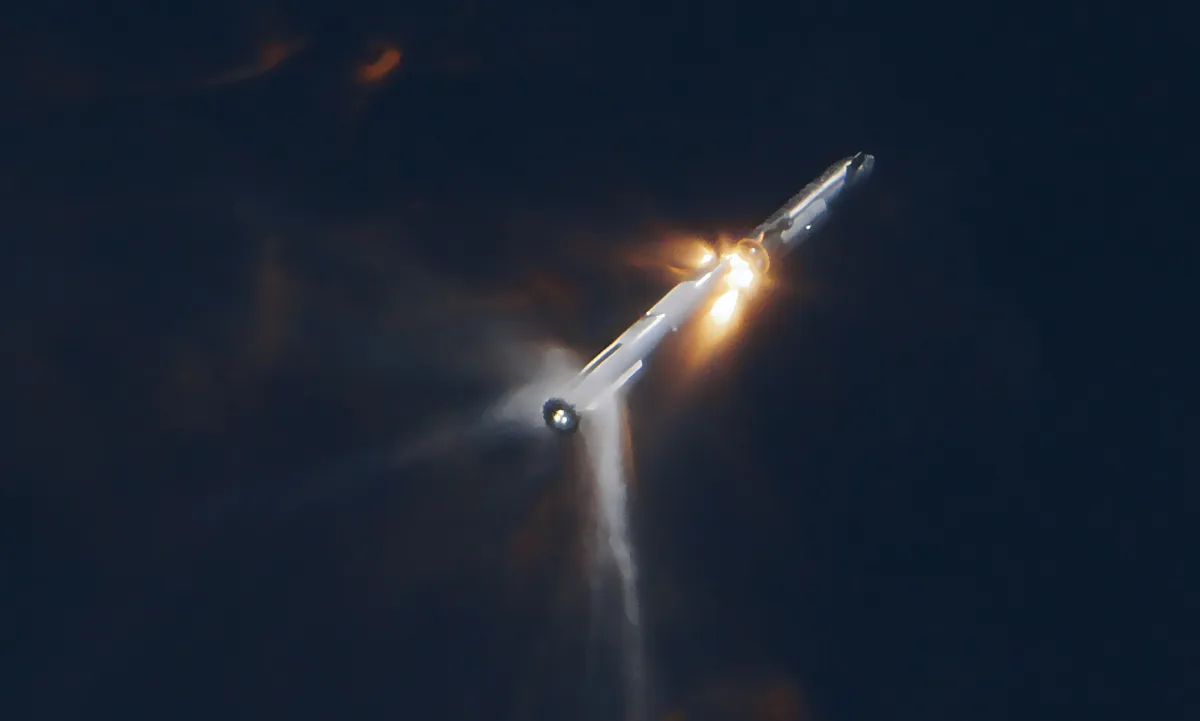The Starship test flight program has captured global attention as SpaceX pushes the boundaries of space exploration. In 2025, Starship stands at the center of humanity’s dream to build a fully reusable, heavy-lift launch system capable of transporting humans and cargo to the Moon, Mars, and beyond. Each test flight brings us closer to this vision, but not without challenges. In this article, we will dive deep into the successes, failures, and future potential of the Starship test flights in 2025. stay with Spaceyv
What Is Starship?
Starship is SpaceX’s next-generation spacecraft designed to revolutionize space travel. The system consists of two stages:
- Super Heavy Booster – A massive first stage designed to provide the thrust necessary to escape Earth’s gravity.
- Starship Upper Stage – A fully reusable spacecraft that can carry humans, satellites, and cargo into space.
The combined system is the tallest and most powerful rocket ever built, standing nearly 120 meters tall and generating over 16 million pounds of thrust at liftoff. Its ultimate purpose: enabling cost-effective space exploration and turning interplanetary travel into a reality.

The Road to the 2025 Test Flight
Before the 2025 Starship test flight, SpaceX conducted several experimental launches in 2021–2024. These flights tested critical systems such as booster separation, heat shields, controlled landings, and reusability. While some ended in spectacular explosions, each test delivered vital data.
By 2025, the technology has advanced considerably:
- New Raptor 3 engines offer greater efficiency and reliability.
- Improved thermal protection systems (TPS) to withstand re-entry heat.
- Enhanced flight software for better guidance and navigation.
- Infrastructure upgrades at the Starbase launch site in Boca Chica, Texas.
Starship Test Flight 2025: Key Highlights
The Starship test flight in 2025 was one of the most anticipated space events of the decade. Here’s what unfolded:
1. Liftoff and Booster Performance
The Super Heavy booster ignited its 33 Raptor engines, producing record-breaking thrust. This stage successfully propelled Starship through the dense layers of Earth’s atmosphere. Unlike previous attempts, engine performance was consistent, marking a significant leap forward.
2. Booster Separation
The hot-stage separation maneuver—a critical milestone—worked flawlessly. Starship separated smoothly from its booster, reducing structural stress and ensuring the spacecraft continued its journey.
3. Orbital Insertion Attempt
The spacecraft nearly reached its intended orbital trajectory. While minor deviations occurred, the progress was a huge leap compared to earlier attempts, signaling improved guidance and navigation systems.
4. Heat Shield and Re-Entry
Re-entry remained the biggest challenge. Starship’s heat shield tiles were tested under extreme conditions. While the shield held up better than in earlier flights, a small section experienced damage, showing the need for further reinforcement.
5. Controlled Splashdown
Although a full landing was not attempted, Starship executed a controlled splashdown maneuver. This was a massive success compared to uncontrolled crashes from earlier years.

Successes of the 2025 Test Flight
- Booster Reliability – Super Heavy proved it can consistently deliver Starship to the edge of space.
- Separation System – Flawless hot-stage separation improved flight safety.
- Improved Navigation – Guidance systems demonstrated increased precision.
- Partial Heat Shield Success – While not perfect, performance was far better than in prior attempts.
- Controlled Descent – Splashdown showed SpaceX is closing in on full reusability.
These milestones bring Starship closer to operational status, aligning with NASA’s Artemis program and SpaceX’s Mars ambitions.
Failures and Challenges
- Heat Shield Durability – The shield still requires improvements to survive repeated re-entries.
- Engine Complexity – Operating 33 Raptor engines simultaneously increases risks of engine-out scenarios.
- Landing Attempts – Full booster and Starship landings remain unachieved, delaying reusability goals.
- Regulatory Delays – FAA approvals and environmental concerns continue to slow the pace of launches.
- Infrastructure Strain – Starbase facilities are under immense pressure to support frequent test flights.
Why the 2025 Test Flight Matters
The 2025 Starship test flight is not just about proving hardware—it’s about shaping the future of space exploration. Each milestone achieved directly impacts upcoming missions:
- NASA’s Artemis III Mission – Starship is contracted to deliver astronauts to the lunar surface.
- Commercial Payloads – Future launches could drastically lower satellite launch costs.
- Mars Colonization – Long-term, Starship is the vehicle designed to transport settlers and supplies to Mars.
Future Potential of Starship
1. Reusability and Cost Reduction
Starship aims to be fully reusable, similar to how airplanes operate. If successful, launch costs could drop from billions to just a few million dollars per mission, opening space to private companies, universities, and smaller nations.
2. Lunar Missions
Starship’s large payload capacity makes it ideal for delivering habitats, rovers, and supplies to the Moon. Its role in NASA’s Artemis program ensures it will be central to lunar exploration.
3. Mars Colonization
Elon Musk’s ultimate goal is to make life multi-planetary. With its massive capacity (up to 100 passengers), Starship could be the vessel that transports the first human settlers to Mars.
4. Satellite Deployment
Starship can carry entire constellations of satellites in a single launch, revolutionizing global internet coverage and communications.
5. Space Tourism and Commercial Flights
As the technology matures, Starship could enable commercial space travel for civilians, offering orbital flights and even point-to-point travel on Earth.
Comparing Starship to Other Rockets
| Rocket | Payload to LEO | Reusability | Status |
|---|---|---|---|
| SpaceX Starship | 150+ tons | Fully reusable (goal) | Testing phase (2025) |
| Falcon 9 | 22.8 tons | Partially reusable | Operational |
| NASA SLS | 95 tons | Not reusable | Operational (limited launches) |
| Blue Origin New Glenn | 45 tons | Partial (planned) | Development phase |
This comparison highlights why Starship is such a game-changer: its payload and reusability potential dwarf competitors.
Public and Industry Reactions
The 2025 test flight sparked global discussions:
- Space Enthusiasts celebrated the progress and milestones achieved.
- Critics pointed out environmental concerns and the risks of large-scale reusability.
- Industry Leaders saw it as a signal of the commercial space race heating up.
The consensus? Despite setbacks, Starship represents the most ambitious leap in spaceflight since the Apollo era.
Conclusion
The Starship test flight of 2025 represents both triumphs and ongoing challenges. While not perfect, the successes prove that humanity is edging closer to a new era of affordable, reusable, and ambitious space exploration. Failures, though costly, are stepping stones toward progress.
Starship is not just another rocket—it is a symbol of humanity’s determination to push boundaries. From the Moon to Mars, and perhaps even beyond our solar system, Starship’s journey has only just begun.
Final Thought: The dream of interplanetary travel is no longer science fiction. With each Starship test flight, we are witnessing the birth of the next chapter in human history.



